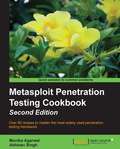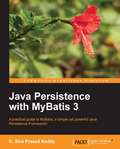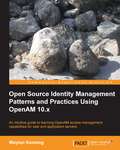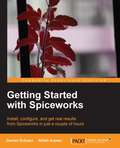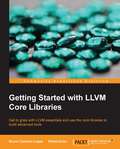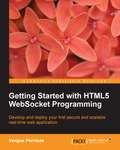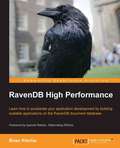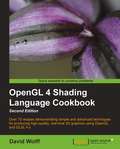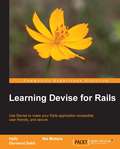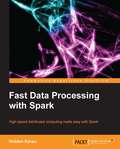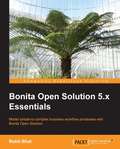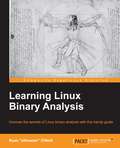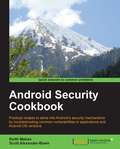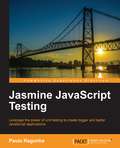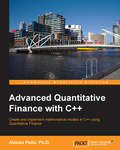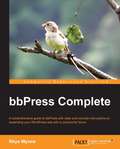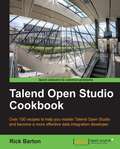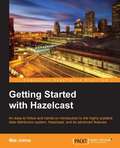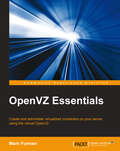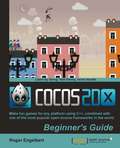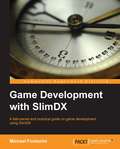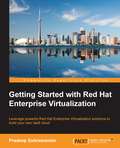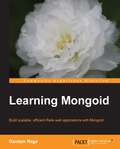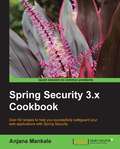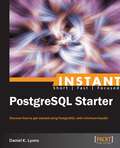- Table View
- List View
Metasploit Penetration Testing Cookbook, Second Edition
by Abhinav Singh Monika AgarwalThis book follows a Cookbook style with recipes explaining the steps for penetration testing with WLAN, VOIP, and even cloud computing. There is plenty of code and commands used to make your learning curve easy and quick.This book targets both professional penetration testers as well as new users of Metasploit, who wish to gain expertise over the framework and learn an additional skill of penetration testing, not limited to a particular OS. The book requires basic knowledge of scanning, exploitation, and the Ruby language.
Java Persistence with MyBatis 3
by K. Siva ReddyThis book will have a practical approach, thus making it easy for the readers to understand and learn with step-by-step instructions.This book is for Java developers who would like to learn all about the MyBatis framework and are looking for a practical guide to get started. The prerequisites required for this book are basic Java and SQL skills. No prior knowledge of MyBatis is expected.
Open Source Identity Management Patterns and Practices Using OpenAM 10.x
by Waylon KenningThis is a Packt Mini in a tutorial format that provides multiple examples on Identity Management using OpenAM 10.x.Open Source Identity Management Patterns and Practices Using OpenAM 10.x is great for developers and architects who are new to Identity Management, and who want a brief overview of what's possible and how to quickly implement a prototype. It's assumed that you've had experience with web applications and some knowledge of Apache and Tomcat.
Getting Started with Spiceworks
by Darren Schoen Nitish KumarThis book will have a getting started approach, thus making it easy for the readers to understand and learn Spiceworks.This book is for any IT pro who wants to make their day easier. With this book, you can go from installing Spiceworks to having a good working knowledge of it in a single afternoon, no Spiceworks experience required! This book assumes no prior experience with Spiceworks. Knowledge of Linux System administration is expected.
Getting Started with LLVM Core Libraries
by Rafael Auler Bruno Cardoso LopesThis book is intended for enthusiasts, computer science students, and compiler engineers interested in learning about the LLVM framework. You need a background in C++ and, although not mandatory, should know at least some compiler theory. Whether you are a newcomer or a compiler expert, this book provides a practical introduction to LLVM and avoids complex scenarios. If you are interested enough and excited about this technology, then this book is definitely for you.
Getting Started with HTML5 WebSocket Programming
by Vangos PterneasGetting Started with HTML5 Websocket Programming takes a tutorial-based approach.This book is for anyone who wants to build high-performance, true, real-time web applications. Being familiar with frontend web development (HTML / XHTML, JavaScript) would be ideal.
RavenDB High Performance
by Brian RitchieRavenDB High Performance is comprehensive yet concise tutorial that developers can use to.This book is for developers & software architects who are designing systems in order to achieve high performance right from the start. A basic understanding of RavenDB is recommended, but not required. While the book focuses on advanced topics, it does not assume that the reader has a great deal of prior knowledge of working with RavenDB.
OpenGL 4 Shading Language Cookbook - Second Edition
by David WolffOpenGL Shading Language 4 Cookbook is a hands-on guide that gets straight to the point - actually creating graphics, instead of just theoretical learning. Each recipe is specifically tailored to satisfy your appetite for producing real-time 3-D graphics using the latest GLSL specification.This book is for OpenGL programmers looking to use the modern features of GLSL 4 to create real-time, three-dimensional graphics. Familiarity with OpenGL programming, along with the typical 3D coordinate systems, projections, and transformations is assumed. It can also be useful for experienced GLSL programmers who are looking to implement the techniques that are presented here.
Learning Devise for Rails
by Hafiz Giovanni Sakti Nia MutiaraA hands-on, step-by-step guide to using Devise for authentication in Rails.If you are a web developer who is getting started with Rails and you are looking for authentication solutions, then this is the book for you. If you are a current Rails developer who is looking to extend your authentication implementation with capabilities such as authorization and remote authentication, this book will also be great for you.
Fastdata Processing with Spark
by Holden KarauThis book will be a basic, step-by-step tutorial, which will help readers take advantage of all that Spark has to offer.Fastdata Processing with Spark is for software developers who want to learn how to write distributed programs with Spark. It will help developers who have had problems that were too much to be dealt with on a single computer. No previous experience with distributed programming is necessary. This book assumes knowledge of either Java, Scala, or Python.
Bonita Open Solution 5.x Essentials
by Rohit BhatA practical, intuitive guide for modeling complex business processes as full-scale applications using the ease and power of Bonita Open Solution.If you are a business application developer looking forward to model business processes intuitively in a workflow, with various conditions and transitions then this book is for you. Basic knowledge of Java or Groovy is necessary to help you develop these applications. Knowledge of HTML and JavaScript/JQuery will be helpful but not mandatory.
Learning Linux Binary Analysis
by Ryan O'NeillIf you are a software engineer or reverse engineer and want to learn more about Linux binary analysis, this book will provide you with all you need to implement solutions for binary analysis in areas of security, forensics, and antivirus. This book is great for both security enthusiasts and system level engineers. Some experience with the C programming language and the Linux command line is assumed.
Android Security Cookbook
by Scott Alexander-Bown Keith MakanAndroid Security Cookbook' breaks down and enumerates the processes used to exploit and remediate Android app security vulnerabilities in the form of detailed recipes and walkthroughs."Android Security Cookbook" is aimed at anyone who is curious about Android app security and wants to be able to take the necessary practical measures to protect themselves; this means that Android application developers, security researchers and analysts, penetration testers, and generally any CIO, CTO, or IT managers facing the impeding onslaught of mobile devices in the business environment will benefit from reading this book.
Jasmine JavaScript Testing
by Paulo RagonhaThe book uses a concise, to-the-point approach to help developers understand and use the power of Jasmine to create better and more maintainable codebases.This book is a must-have guide for web developers who are new to the concept of unit testing. It's assumed that you have a basic knowledge of JavaScript and HTML.
Advanced Quantitative Finance with C++
by Alonso PenaThe book takes the reader through a fast but structured crash-course in quantitative finance, from theory to practice. If you are a quantitative analyst, risk manager, actuary, or a professional working in the field of quantitative finance and want a quick hands-on introduction to the pricing of financial derivatives, this book is ideal for you. You should be familiar with the basic programming concepts and C++ programming language. You should also be acquainted with calculus of undergraduate level.
bbPress Complete
by Rhys WynneA concise guide, written in an easy-to-follow format.This book is aimed at ambitious website or blog owners looking to add a forum to their site quickly and easily. Basic experience in WordPress and with managing a website is expected. Knowledge of HTML and PHP will be a bonus, though it isn't necessary.
Talend Open Studio Cookbook
by Rick BartonPrimarily designed as a reference book, simple and effective exercises based upon genuine real-world tasks enable the developer to reduce the time to deliver the results. Presentation of the activities in a recipe format will enable the readers to grasp even the complex concepts with consummate ease.Talend Open Studio Cookbook is principally aimed at relative beginners and intermediate Talend Developers who have used the product to perform some simple integration tasks, possibly via a training course or beginner's tutorials.
Getting Started with Hazelcast
by Mat JohnsWritten as a step-by-step guide, Getting Started with Hazelcast will teach you all you need to know to make your application data scalable.This book is a great introduction for Java developers, software architects, or developers looking to enable scalable and agile data within their applications. You should have programming knowledge of Java and a general familiarity with concepts like data caching and clustering.
OpenVZ Essentials
by Mark FurmanOpenVZ (Open Virtuozzo) is an OS-level virtualization technology based on the Linux kernel and OS written in C. It creates multiple secure and isolated Linux containers on a single physical server, enabling better server utilization and ensuring that applications do not conflict. OpenVZ is the only highly scalable virtualization technology with near-zero overhead, strong isolation, and rapid customer provisioning that's ready for production use right now. Starting with the very basics of OpenVZ, you will learn to configure templates, create containers, administer your server infrastructure, and utilize the OpenVZ Web Panel. Packed with practical examples and precise instructions, this book helps you to set up and configure OpenVZ. An easy-to-follow guide that will help you with real-world container administration tasks. The book has a natural flow from one topic to another and will ensure that you gain expertise in the effective implementation of OpenVZ.
Cocos2d-x by Example Beginner's Guide
by Roger EngelbertGet to grips with Cocos2D-X using step-by-step examples. Roger Engelbert will have you smiling throughout and learning valuable information at every turn.If you have brilliant ideas for amazing games and want to bring them to life, then this book is what you need. Work through easy-to-follow examples and learn exactly what you need to know to make your games a reality.No programming experience necessary!
Game Development with SlimDX
by Michael FontaniniAn easytofollow guide on SlimDX game development with practical exercises in each chapter. Stepbystep instructions and example code put each topic into action in a working demo.If you are a game designer or game developer with a passion for video games and a desire to create your own from scratch, this is the book for you. You will need basic programming experience in C#(C Sharp) to get the most out of this book.
Getting Started with Red Hat Enterprise Virtualization
by Pradeep SubramanianIf you are a system administrator who is interested in implementing and managing open source virtualization infrastructures, this is the book for you. A basic knowledge of virtualization and basic Linux command line experience is needed.
Learning Mongoid
by Gautam RegeIf you are an application developer who wants to learn how to use Mongoid in a Rails application, this book will be great for you. You are expected to be familiar with MongoDB and Ruby.
Spring Security 3.x Cookbook
by Anjana MankaleThis book follows a cookbook style exploring various security solutions provided by Spring Security for various vulnerabilities and threat scenarios that web applications may be exposed to at the authentication and session level layers.This book is for all Spring-based application developers as well as Java web developers who wish to implement robust security mechanisms into web application development using Spring Security.Readers are assumed to have a working knowledge of Java web application development, a basic understanding of the Spring framework, and some knowledge of the fundamentals of the Spring Security framework architecture. Working knowledge of other web frameworks such as Grails and so on would be an added advantage to exploit the whole breadth of recipes provided in this book, but this is not mandatory.
Instant PostgreSQL Starter
by Daniel K LyonsGet to grips with a new technology, understand what it is and what it can do for you, and then get to work with the most important features and tasks. Instant PostgreSQL Starter is a step-by-step guide to getting a PostgreSQL database up and running, with an accessible approach that helps you perform some initial steps with setup and optimization.If you're completely new to databases you'll benefit from this book's step-by-step approach to getting PostgreSQL installed and running. If you're curious about what sets PostgreSQL apart, you'll get a taste of the diverse features it has to offer. All you need to get started is this book and an Internet connection.
